Adopting a raw diet comes with risks like bacterial contamination from pathogens such as Salmonella, E. coli, and Listeria, which can cause serious illness. To stay safe, handle raw foods carefully, sanitize surfaces, store ingredients properly at or below 40°F, and keep raw and cooked foods separate. Proper hygiene and storage are essential. If you want to understand how to minimize these risks and maintain nutritional balance, there’s more you should know.
Key Takeaways
- Handling raw foods increases the risk of bacterial contamination like Salmonella and E. coli; proper hygiene and sanitation are essential.
- Store raw ingredients separately, at or below 40°F, and in airtight containers to prevent cross-contamination and bacterial growth.
- Incorporate cooked foods and fortified products to address potential nutritional deficiencies such as Vitamin B12 and Omega-3s.
- Gradually transition to raw diets, monitor health responses, and consult professionals to ensure nutritional balance and safety.
- Recognize signs of foodborne illness, including nausea, diarrhea, and fever, and seek prompt medical attention if symptoms occur.
Understanding the Risks of Bacterial Contamination
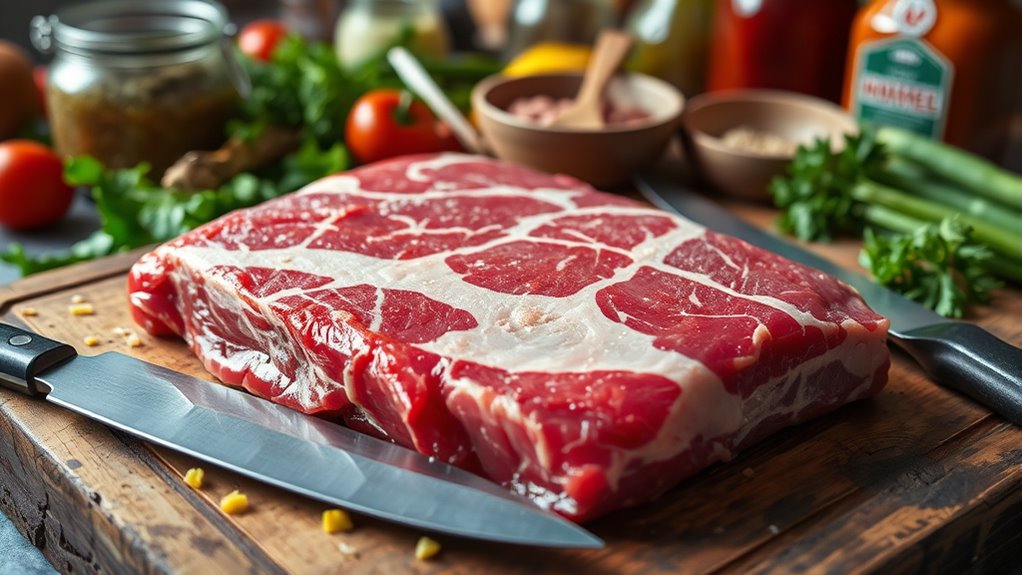
Because raw diets often include uncooked meat and bones, they pose a significant risk of bacterial contamination. Microbial hazards like Salmonella, E. coli, and Listeria can thrive on raw ingredients, increasing the chance of foodborne illnesses. To minimize these risks, you need to follow strict food safety protocols, such as proper hygiene, thorough cleaning, and safe storage practices. Handling raw ingredients carefully reduces cross-contamination with other foods and surfaces. Always wash your hands before and after preparing raw meat or bones, and sanitize all utensils and surfaces used. Being aware of microbial hazards and adhering to recommended safety measures helps protect you and others from potential infections associated with raw diets. Staying vigilant is key to maintaining a safe raw food environment.
Common Food Safety Concerns With Raw Ingredients

When preparing raw ingredients, bacterial contamination is a major concern that you need to address. To keep your food safe, you should follow proper handling techniques and prevent cross-contamination. Being mindful of these measures helps reduce risks and guarantees your meals stay safe to eat. Utilizing proper sanitation practices can also help maintain the integrity of your ingredients during preparation.
Bacterial Contamination Risks
Are you aware of the bacterial risks associated with raw ingredients in a raw diet? Spoilage bacteria can quickly grow on raw foods, leading to unpleasant odors and potential health issues. Surface contamination is a common way bacteria like Salmonella or E. coli transfer from the environment or handling onto your ingredients. These bacteria can survive on the surface of raw meats, fruits, and vegetables, especially if not stored or prepared properly. Even if food looks fresh, it might harbor harmful bacteria invisible to the naked eye. Consuming contaminated raw ingredients increases your risk of foodborne illnesses, which can cause symptoms from mild stomach upset to severe infections. Being mindful of surface contamination and spoilage bacteria helps you reduce bacterial risks and keep your raw diet safe. Additionally, maintaining proper food safety practices such as thorough washing and proper storage can significantly lower these risks. Recognizing signs of spoilage bacteria early can also help prevent health issues before consuming raw foods. Understanding how bacterial contamination occurs in raw ingredients emphasizes the importance of vigilant handling and hygiene. Practicing proper hygiene and storage techniques further minimizes the chances of bacterial growth.
Cross-Contamination Prevention Measures
To effectively prevent cross-contamination when handling raw ingredients, you need to follow strict hygiene practices. Start with proper kitchen sanitation by regularly cleaning surfaces and utensils. When sourcing ingredients, choose reputable suppliers to minimize contamination risks. Implement these measures:
- Use separate cutting boards and knives for raw meats and produce.
- Wash your hands thoroughly before and after handling raw ingredients.
- Sanitize countertops and equipment after each use.
- Store raw ingredients separately, ideally on the bottom shelf of the refrigerator to prevent drips.
- Be aware of kitchen contamination and how it can occur if proper precautions are not taken. Maintaining food safety practices is essential to prevent the spread of harmful bacteria.
Proper Food Handling Techniques
Proper food handling techniques are essential for maintaining safety with raw ingredients. When you’re doing food prep, always wash your hands thoroughly before touching raw items. Use separate cutting boards and utensils for raw meats and produce to prevent cross-contamination. Keep your workspace clean by practicing good kitchen sanitation—wipe down surfaces regularly and sanitize tools after use. Store raw ingredients at the correct temperatures to inhibit bacterial growth, and never leave raw food out for extended periods. Proper handling also means avoiding rinsing raw meat aggressively, as this can spread bacteria. Staying vigilant with food prep practices reduces the risk of foodborne illness and keeps your raw diet safe. Focus on cleanliness, organization, and proper storage for ideal safety. Additionally, understanding proper food storage techniques can further minimize risks associated with raw ingredients. Being aware of common food safety concerns related to raw foods helps you identify potential hazards early and respond appropriately.
Nutritional Imbalances and Deficiencies

A raw diet can leave you missing key nutrients your body needs to stay healthy. Without proper balance, you risk developing vitamin deficiencies that affect your energy and immunity. It’s important to understand how these gaps can impact your overall well-being. Proper nutrition is essential for maintaining a healthy and balanced diet, especially when choosing alternative eating patterns. Incorporating a variety of food sources can help prevent nutritional imbalances common in restrictive diets. Additionally, understanding the role of data privacy regulations can help consumers make informed choices about their health data management.
Essential Nutrients Missing
Raw diets often lack essential nutrients that your body needs to function properly, which can lead to serious deficiencies over time. Without these critical nutrients, your health can suffer considerably. For example:
- Vitamin B12 – vital for nerve function and red blood cell production.
- Iron – necessary for oxygen transport and energy levels.
- Omega-3 fatty acids – important for brain health and inflammation control.
- Calcium – essential for strong bones and teeth.
Since raw diets typically exclude fortified foods and cooked options, you risk missing out on these key essential nutrients. Nutritional gaps can develop if these deficiencies are not addressed, potentially leading to long-term health issues if not carefully managed. It is also crucial to understand the importance of nutritional balance to prevent these deficiencies from occurring. Incorporating balanced nutrients into your diet can help mitigate these risks and ensure you receive all necessary nutrients. Additionally, paying attention to dietary variety can support overall nutritional adequacy.
Risk of Vitamin Deficiency
You are trained on data up to October 2023. A raw diet may lead to nutritional imbalances that increase the risk of vitamin deficiencies if not carefully managed. Ensuring a balanced intake of essential nutrients is crucial because sound design principles highlight the importance of proper layering and synthesis to create a cohesive outcome; similarly, a balanced diet requires careful combination of foods to meet nutritional needs.
Risks Associated With Raw Dairy and Animal Products
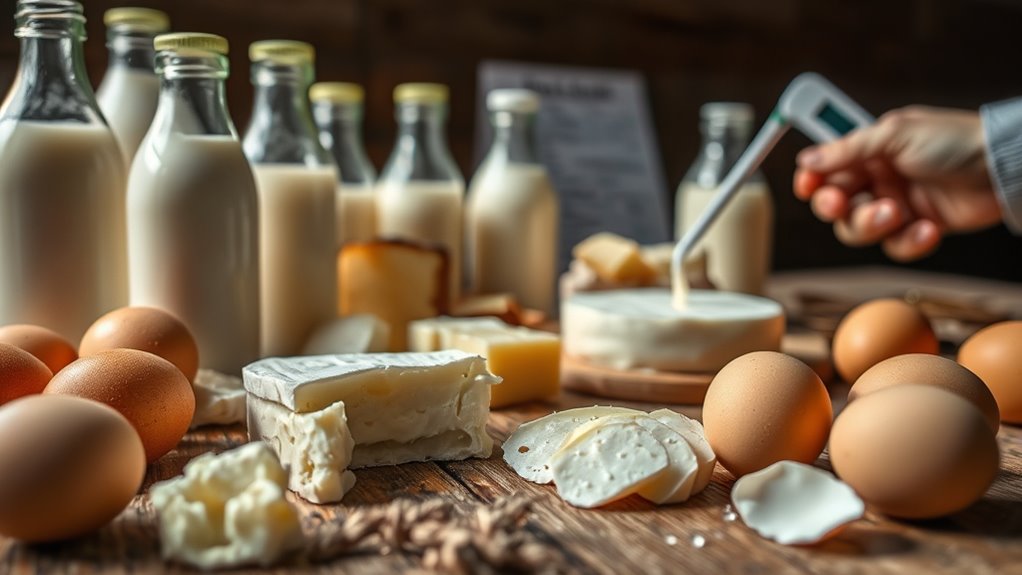
Consuming raw dairy and animal products considerably increases your risk of exposure to harmful bacteria such as Salmonella, E. coli, and Listeria. Raw milk and other unprocessed animal products can harbor these pathogens without visible signs. To understand the risks better:
- Contamination Sources: Bacteria can originate from infected animals, improper handling, or contaminated environments. Proper handling and sourcing from reputable suppliers can reduce but not eliminate the risk. Additionally, shower best practices for cleaning and sanitizing equipment can further minimize bacterial transfer.
- Health Consequences: Infections may cause severe gastrointestinal illness, dehydration, or more serious complications.
- Vulnerable Populations: Pregnant women, children, and immunocompromised individuals face higher risks.
- Prevention Challenges: Even pasteurization helps eliminate bacteria, but raw consumption bypasses this safety step. Always be cautious with raw milk and animal products to reduce these risks. Additionally, awareness of the father-daughter bond and shared stories can serve as a reminder of the importance of nurturing and protecting loved ones from avoidable health hazards. Recognizing food safety practices as a critical component can further help mitigate potential dangers.
Proper Food Handling and Hygiene Practices
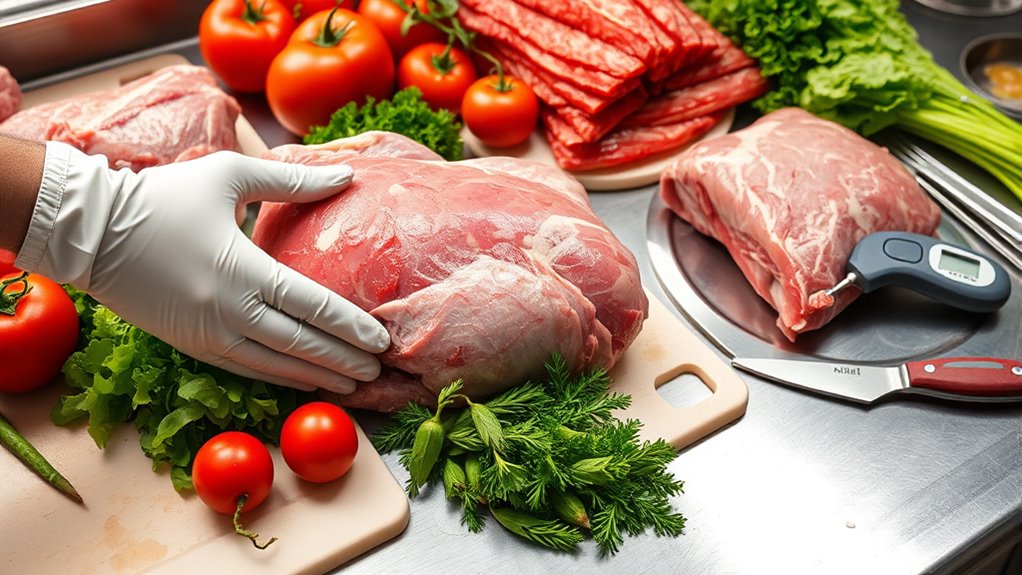
You need to store raw foods properly to keep them safe and maintain freshness. Always prevent cross-contamination by separating raw meats from other ingredients and cleaning surfaces thoroughly. Practicing good hygiene helps reduce the risk of foodborne illnesses and keeps your diet safe. Additionally, using proper food storage techniques can further minimize health risks associated with raw diets. Selecting appropriate containers and storage methods can also help extend the shelf life of raw ingredients and maintain their quality. Proper temperature control is essential to inhibit bacterial growth and preserve the nutritional value of raw foods. Ensuring your storage areas have appropriate filtration systems can also help prevent the spread of contaminants.
Safe Food Storage
Proper food storage is essential to prevent contamination and guarantee the safety of a raw diet. Always check food labeling to verify freshness and proper use-by dates. Use appropriate packaging materials that are food-safe and non-porous to avoid bacterial growth. To maintain maximum safety:
- Store raw foods separately from cooked or ready-to-eat items.
- Keep raw meats on the bottom shelf of the fridge to prevent drips.
- Maintain your fridge at or below 40°F (4°C) to slow bacterial growth.
- Label containers clearly with dates for proper inventory control.
Prevent Cross-Contamination
Effective food handling and hygiene practices are essential for preventing cross-contamination in a raw diet. Start by maintaining excellent kitchen sanitation, regularly cleaning surfaces, utensils, and cutting boards to stop bacteria transfer. Always wash your hands thoroughly before handling ingredients, especially after touching raw meats or produce. Be mindful of ingredient sourcing; choose reputable suppliers to reduce the risk of contamination. Keep raw meats separate from vegetables and cooked foods, using different cutting boards and knives. Store raw ingredients on the bottom shelves of your fridge to prevent drips onto other foods. Properly sanitize all equipment and workspace after each use. By following these practices, you minimize the risk of cross-contamination, keeping your raw diet safe and healthy.
Selecting Safe and Fresh Raw Foods
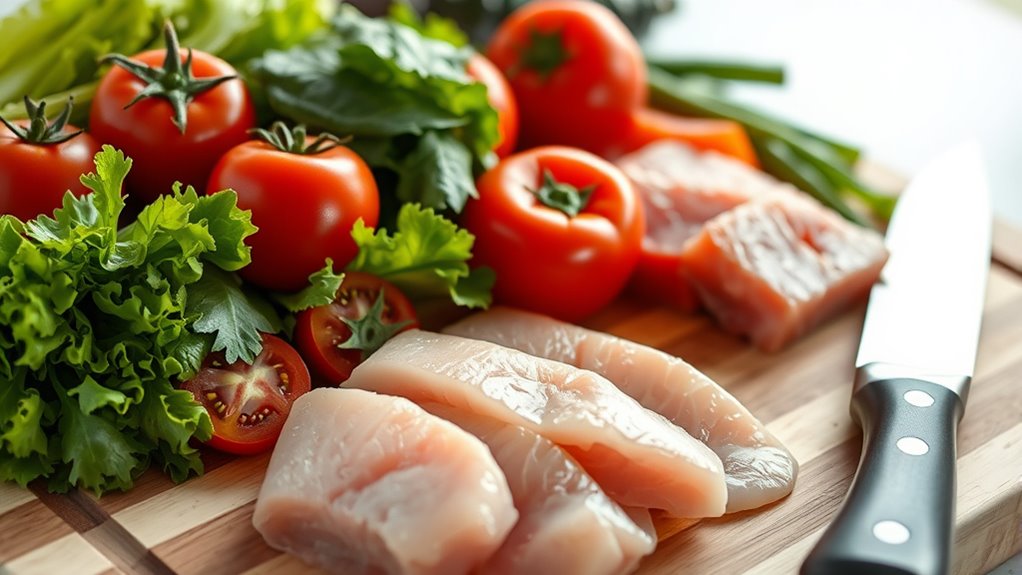
Choosing safe and fresh raw foods is essential to minimize health risks associated with raw diets. To do this effectively, you should:
- Choose organic options whenever possible to reduce pesticide exposure.
- Source from local producers who follow proper handling and hygiene practices.
- Inspect produce for freshness—look for vibrant color, firm texture, and no signs of spoilage.
- Buy in small quantities, ensuring foods are used quickly to maintain freshness and prevent spoilage.
The Importance of Proper Storage and Temperature Control
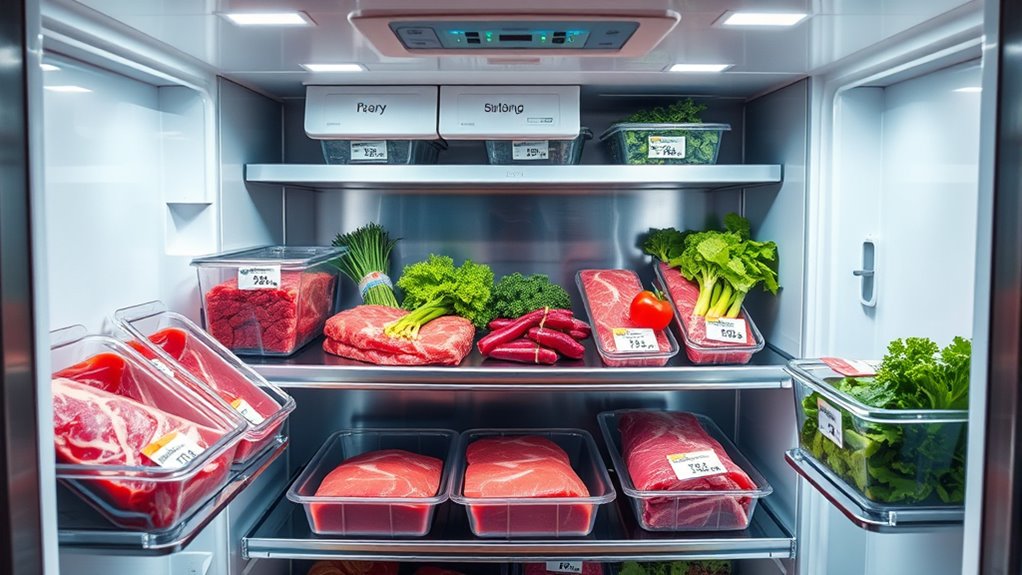
Once you’ve selected fresh, safe raw foods, storing them correctly becomes the next step to prevent spoilage and reduce health risks. Proper storage is essential to maintain food quality and safety. You should keep raw meats and seafood in airtight containers or tightly sealed bags to prevent cross-contamination. Temperature control is critical; always refrigerate at or below 40°F (4°C) and freeze items that won’t be used immediately. Use a thermometer to monitor your fridge’s temperature regularly. Avoid leaving raw foods out at room temperature for extended periods, as bacteria can grow rapidly. Proper storage and consistent temperature control help inhibit bacterial growth, ensuring your raw diet remains safe and fresh for consumption.
Recognizing Signs of Foodborne Illness
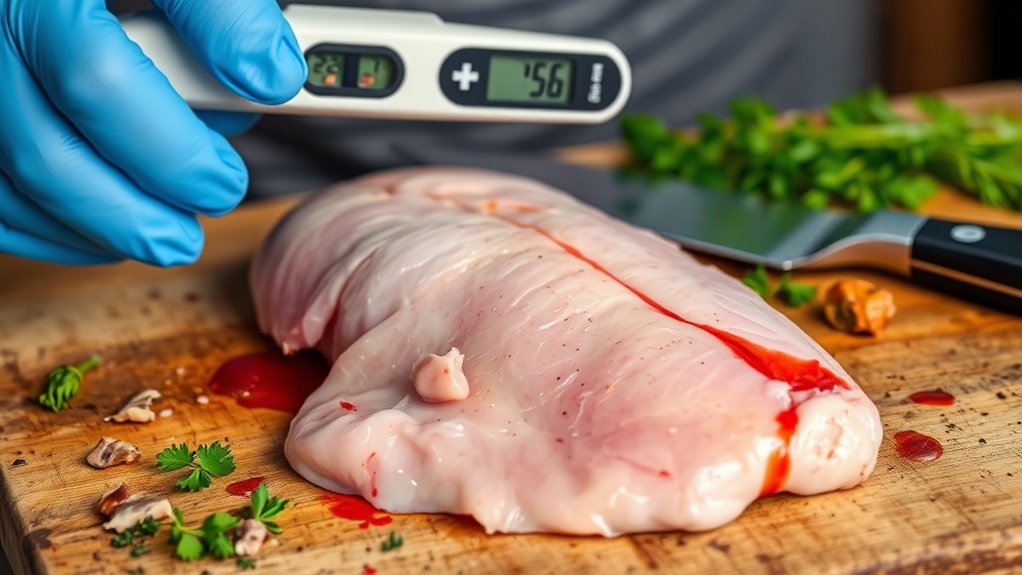
Foodborne illnesses can develop quickly after consuming contaminated raw foods, so it’s important to recognize their early signs. If you notice symptoms like nausea, vomiting, or diarrhea shortly after eating, you may be dealing with food poisoning. Watch out for these signs:
- Abdominal cramping that worsens over time
- Persistent vomiting or diarrhea lasting more than a day
- Fever higher than 101°F (38.5°C) or chills
- Blood in stool or urine, which indicates severe infection
Early detection helps prevent complications and limits the spread of antibiotic-resistant bacteria. Recognizing these symptoms promptly ensures you seek treatment quickly, reducing the risk of long-term health issues from food poisoning. Stay vigilant, especially when handling raw foods that may harbor dangerous pathogens.
Alternatives to Raw Foods for Nutritional Balance
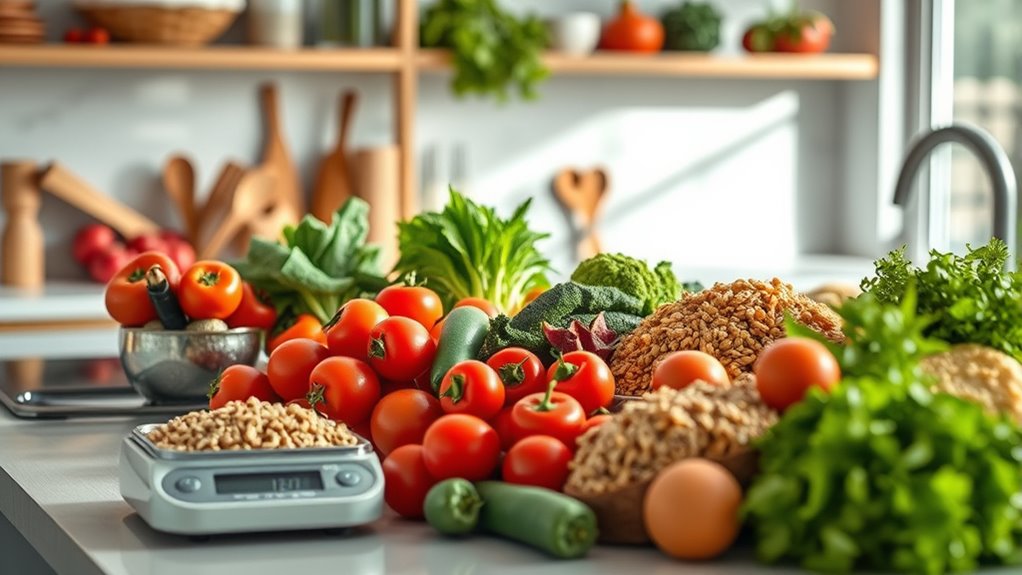
While consuming raw foods can pose health risks due to potential contamination, there are safer ways to achieve a balanced diet without compromising nutrition. Incorporating cooked foods, fortified products, and dietary supplements guarantees you meet your nutritional needs. Emphasizing diet diversity helps prevent deficiencies and promotes overall health. You can use nutritional supplementation to fill gaps in your diet, especially for nutrients like vitamin B12 or omega-3s, which are less available in plant-based options. To visualize, here’s a quick comparison:
| Raw Foods Approach | Alternative Strategies |
|---|---|
| Potential contamination | Cooked foods and proper food handling |
| Limited diet diversity | Incorporate various food groups and supplements |
| Nutritional gaps | Use fortified foods and targeted supplementation |
Tips for Transitioning Safely to a Raw Diet
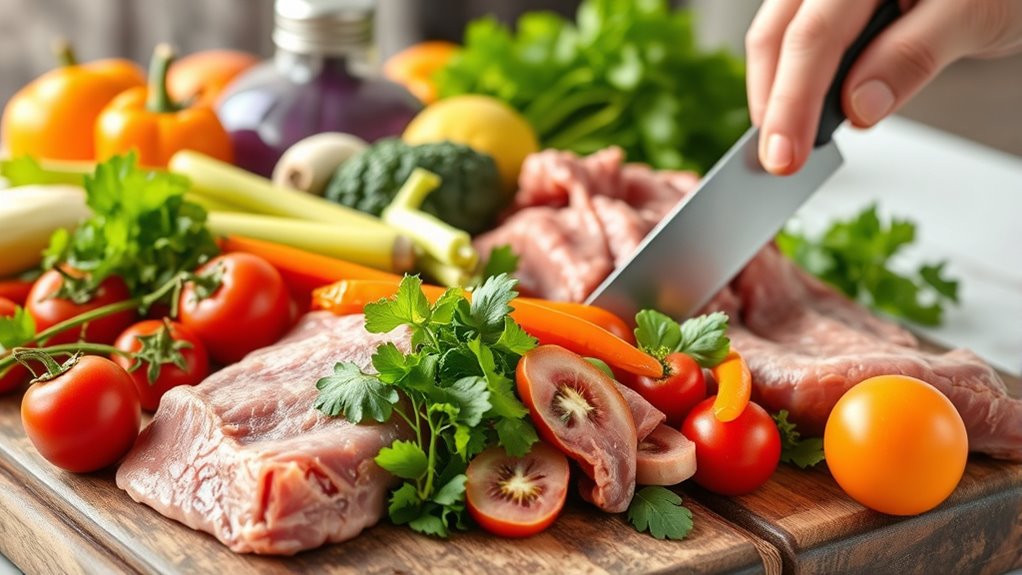
Switching safely to a raw diet requires careful planning and gradual changes. You should start by adjusting your cooking methods, focusing on raw preparations like chopping, blending, or fermenting instead of cooking. Incorporate dietary supplements if needed to fill nutritional gaps, especially for vitamin B12, iron, and omega-3s. To facilitate a smooth transition:
- Gradually replace cooked foods with raw alternatives over several weeks.
- Focus on variety to avoid deficiencies and improve nutrient intake.
- Keep an eye on your body’s response and adjust accordingly.
- Consult with a healthcare professional or nutritionist regularly.
Frequently Asked Questions
How Can I Tell if a Raw Food Is Truly Fresh?
To tell if raw food is truly fresh, look for freshness indicators like vibrant color, firm texture, and a clean smell. Check for any sliminess or discoloration, as these suggest spoilage. Proper storage techniques, such as keeping foods at the right temperature and using airtight containers, help maintain freshness longer. Trust your senses and always inspect before use to guarantee you’re consuming the freshest, safest raw food.
What Are the Best Ways to Prevent Cross-Contamination?
To prevent cross-contamination, you should follow proper handwashing protocols before and after handling raw foods. Always use separate cutting boards and utensils for raw and cooked items, and clean them thoroughly after each use. Adhere to storage guidelines by keeping raw foods separate and stored at appropriate temperatures. Regularly disinfect surfaces and wash your hands to minimize bacteria transfer, ensuring a safer environment for everyone.
Are There Specific Populations Who Should Avoid Raw Diets?
Oh, the irony isn’t lost—some populations should definitely avoid raw diets. If you’re vulnerable, like pregnant women, young children, the elderly, or those with compromised immune systems, raw foods pose serious health risks. Dietary restrictions aside, their immune defenses aren’t strong enough to handle potential pathogens. So, despite the trendy appeal, you should steer clear if your health or age makes you more susceptible to foodborne illnesses.
How Do Raw Diet Risks Compare to Cooked Diets?
When comparing raw diet risks to cooked diets, you should consider food safety and nutritional balance. Raw diets often carry higher risks of bacterial contamination, which can lead to foodborne illnesses. While raw foods might preserve some nutrients better, cooking can enhance nutrient availability and reduce harmful microbes. You need to weigh these factors carefully, especially if you have a compromised immune system or specific health concerns, to choose the safest and most nutritious option.
What Are the Legal Considerations for Selling Raw Foods?
When selling raw foods, you need to consider legal factors like food safety and labeling regulations. You must ensure your products meet health standards to prevent contamination and protect consumers. Accurate labeling is essential, including ingredients, storage instructions, and expiration dates. Failing to comply can lead to fines or product recalls. Stay informed about local laws and industry guidelines to keep your business compliant and maintain customer trust.
Conclusion
Switching to a raw diet might seem like a simple way to boost your health, but the risks are more serious than you think—bacterial contamination and nutritional gaps can be overwhelming. By following proper handling, storage, and hygiene practices, you can protect yourself from dangerous illnesses. Remember, your health isn’t worth risking for a quick fix—make informed choices, and don’t let your pursuit of wellness turn into a health disaster. Stay safe and prioritize your well-being!










